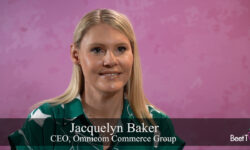SAN JUAN, PR — In an era where the lines between digital convenience and traditional viewing experiences are blurring, consumers are embracing the next wave of advertising innovation: shopping via their television screens.
This shift has transformed the advertising landscape, enabling brands to capitalize on what Tony Marlow, CMO of LG Ad Solutions, calls “performance storytelling”.
He was interviewed by Beet.TV senior editor Rob Williams at Beet Retreat San Juan 2024.
The Rise of Shoppable TV
“Consumers seem to be telling us…they want to shop via their TV,” Marlow says, referencing a recent piece of research.
The findings are clear: there’s a growing appetite for interactive and shoppable content directly from the comfort of one’s couch. Marlow cites the success of a recent campaign featuring a Barbie ad with a QR code that led viewers to purchase cinema tickets.
The idea of “interactive TV” with ecommerce tacked-on is nothing new. People have been dreaming of such a future since at least the 1990s.
“The technology has actually existed for a while,” Marlow adds, stressing that the novelty lies not in the tech itself but in “consumers’ openness to it”. It’s an openness that seems to have burgeoned only recently, he observes, making 2024 a pivotal year for shoppable TV.
Performance Storytelling: The New Norm
But the concept of performance storytelling, as Marlow puts it, is breaking new ground. “It’s no longer the case that you need to choose between being a brand marketer or a performance marketer,” Marlow explains.
The convergence of the emotive power of traditional TV and the precision of digital advertising has created a hybrid that satisfies both branding and performance metrics.
This duality is particularly potent in connected TV (CTV), which marries the “sight, sound, motion” that brand marketers love with the “addressability, accountability, [and] measurability” that digital marketers demand.
Political Spending and CTV: A Match for the Times
With 2024 being a big election year, Marlow predicts a significant uptick in political ad spending on CTV platforms. “Ad supported streaming television…was not really a thing” in the last presidential cycle, he notes. This time around, however, the “available footprint of inventory”” has grown substantially, presenting an unprecedented opportunity for political campaigns.
“Some people believe that connected TV could even sway the election,” Marlow points out. The ability to customize messaging for specific electoral districts could give parties the edge they need, he suggests.
This level of customization is a testament to the platform’s maturation and its potential impact on significant political outcomes.
The Walmart Move: An Indicator of CTV’s Value
LG Ad Solutions, a subsidiary of LG Electronics, provides a platform for advertisers to target and deliver content across various connected LG devices.
The company specializes in leveraging data analytics to enhance ad targeting and optimize campaign performance.
The service encompasses an array of LG smart TVs, enabling contextually-relevant advertisements.
When asked about Walmart’s recent move to acquire television manufacturer Vizio, which operates in the same space, Marlow emphasizes the broader implications for the advertising industry.
“It’s not really about manufacturing TVs…It’s about the advertising footprint,” he asserts. This decision by the retail giant underscores the growing recognition of CTV’s value in the advertising ecosystem.
Marlow finds the situation “interesting” and filled with questions, particularly regarding existing agreements with operating systems and Automatic Content Recognition (ACR) technology. Nevertheless, he concludes that the move “underscores the value of connected TV and connected TV advertising.”
You’re watching Beet.TV’s coverage of Beet Retreat San Juan 2024. This series and event is sponsored by Albertsons Media Collective, Moloco, OpenX and TransUnion. For more videos from the series, please visit this page.














































